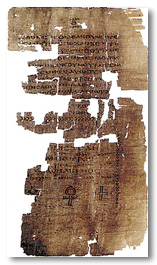The Gnostic Gospels
- REV. WILLIAM SAUNDERS
The Da Vinci Code talks about the gnostic gospels. What are the gnostic gospels?
 |
Recall Straight Answers response last week to the question, Who wrote the Gospels? The four Gospels included in our New Testament Matthew, Mark, Luke and John were written prior to A.D. 100 and recent scholarship on ancient papyrus documents point to an even earlier date of A.D. 70. These four Gospels are rooted in the apostolic tradition and can be attributed to apostolic authorship: St. Matthew was an apostle; St. Mark was a disciple of St. Peter; St. Luke was a disciple of St. Paul and knew our Blessed Mother; and St. John was an apostle and was the guardian of our Blessed Mother until the time of her assumption. These Gospels are orthodox in their teaching, particularly about the identity and person of Jesus. They were used in the Mass and other liturgical functions. Finally, they were accepted by the whole Church, not just by some sect. Evidence of the existence and use of these Gospels is found in St. Justin the Martyrs First Apology (c.150), St. Irenaeus Adversus haereses (c.180), the Muratorian Fragment (c. 155), and the Letter to Papias (c.130). (Note that St. Irenaeus works against gnosticism are of particular importance because he was a student of St. Polycarp, who was a student of St. John the Apostle.)
What then are the gnostic gospels? To answer this question, we must first understand what gnosticism is. Gnosticism refers to a religious belief that was espoused by perhaps a dozen or more rival sects located in the areas of Syria, Egypt, Greece and Italy about the year A.D. 100. The gnostics espoused a dualistic system: A God who was the source of all good and everything spiritual versus a Devil who was the source of all evil and everything material. For them, God and the Devil were equal in power. (Remember that Catholics believe that the Devil is a creature, a fallen angel, who definitely is not equal to God in any way.) Spiritual aeons were the intermediaries between God and the material world. A human beings person body and soul was corrupt, being part of the physical world; the persons spirit a divine spark was imprisoned within the body. The way to release the divine spark required a special knowledge, a gnosis.
The gnostics espoused a dualistic system: A God who was the source of all good and everything spiritual versus a Devil who was the source of all evil and everything material. For them, God and the Devil were equal in power. |
Jesus, a created aeon, entered this world entering the body of a human Jesus. The aeon Jesus revealed this gnosis. However, at the crucifixion, the aeon Jesus left the body of the human Jesus to return to the heavens. For example, in the gnostic Gospel of Judas (so highly publicized by the National Geographic Society), Jesus supposedly said to Judas, You will exceed all of them. For you will sacrifice the man that clothes me. In other words, Judas will facilitate the killing of the human Jesus, thereby liberating the aeon Jesus. Therefore, the gnostics deny the incarnation, the sacrifice of the cross for our sins, and the resurrection; as such, they deny the mystery of redemption and salvation as Christians believe.
Because of these warped beliefs, the gnostics denied the sacraments, because God would never use material things, like bread and wine, water or oil, through which to convey grace. They did not make the sign of the cross, because the divine aeon Jesus did not die on the cross as a sacrifice for our sins. They avoided eating meat because it is physical flesh. They abstained from marriage and marital love, so as not to create a child and imprison him in a wretched body. Interestingly, some gnostics engaged in orgies as an expression of contempt for the body and the moral laws of marriage. (Recall in The Da Vinci Code how the great religious ceremony was ritualized fornication.)
These gnostic groups composed their writings, and labeled them with titles, such as The Gospel of Thomas or The Gospel of Philip or The Acts of Peter. Of course none of these works can be traced to the apostolic times or apostolic authorship. The gnostics appended the names of the saints to these bogus writings to give them some credibility. Again these writings cannot be traced to the apostolic age when the writings of the New Testament appeared, they cannot be linked to the witness of an apostle or disciple, and they are heretical. Little wonder the Church condemned these writings.
 This is Meaghen Gonzalez, Editor of CERC. I hope you appreciated this piece. We curate these articles especially for believers like you.
This is Meaghen Gonzalez, Editor of CERC. I hope you appreciated this piece. We curate these articles especially for believers like you.
Please show your appreciation by making a $3 donation. CERC is entirely reader supported.

Acknowledgement
Saunders, Rev. William. "The Gnostic Gospels." Arlington Catholic Herald.
This article is reprinted with permission from Arlington Catholic Herald.
The Author

 Father William Saunders is pastor of Our Lady of Hope parish in Potomac Falls, Virginia. He is dean of the Notre Dame Graduate School of Christendom College. The above article is a "Straight Answers" column he wrote for the Arlington Catholic Herald. Father Saunders is the author of Straight Answers, a book based on 100 of his columns, and Straight Answers II.
Father William Saunders is pastor of Our Lady of Hope parish in Potomac Falls, Virginia. He is dean of the Notre Dame Graduate School of Christendom College. The above article is a "Straight Answers" column he wrote for the Arlington Catholic Herald. Father Saunders is the author of Straight Answers, a book based on 100 of his columns, and Straight Answers II.




